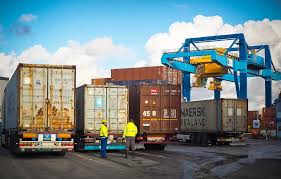Intermodal Freight: The Ultimate Logistics Juggling Act (And Why Smart Shippers Love It)
Picture this: Your shipment starts its journey on a truck, gets loaded onto a train for the long haul, transfers to a barge for a river crossing, then finishes with a short truck ride to the warehouse. No, this isn’t a logistics fantasy—it’s intermodal freight, the unsung hero of cost-effective, efficient shipping.
Forget “either/or” thinking. The future is “yes, and”—using the best parts of trucks, trains, and ships to move freight smarter. Here’s why intermodal is having a moment (and how to make it work for your business).
Intermodal 101: It’s Like a Relay Race for Your Freight
At its core, intermodal means one shipment, multiple transport modes, all without unloading and reloading the actual cargo. How? Standardized containers that fit on:
- 🚛 Truck chassis (for first/last mile)
- 🚂 Rail flatcars (for the long middle stretch)
- 🚢 Container ships (when going overseas)
*”We moved 500 containers of auto parts Detroit-to-LA. By rail for the bulk miles, then trucks for the final delivery. Saved $200K vs. all-truck.”* — Automotive logistics manager
Why Intermodal Is Killing It Right Now
1. The Fuel Savings Will Make You Cry Happy Tears
- Trains move 1 ton of freight 470 miles on 1 gallon of diesel
- That’s 3-4X more efficient than trucks
- Even with drayage (short truck hops), you save 15-40% per load
2. Capacity When You’re Desperate
Truck shortage? Intermodal gives you:
✅ Access to rail capacity (no CDL driver required)
✅ More predictable scheduling (trains don’t quit for better pay)
✅ No ELD hassles (rail doesn’t have hours-of-service rules)
3. The Green Factor (That Actually Saves You Green)
Sustainability isn’t just PR—it pays:
🌱 67% lower emissions than all-truck moves
📉 Carbon credits some companies monetize
🛒 Walmart/Target/etc. prioritize low-carbon shippers
The Nuts and Bolts: How Intermodal Really Works
The Players:
- Drayage carriers (Short-haul truckers to/from rail yards)
- Class I railroads (BNSF, UP, CSX, etc.)
- Steamship lines (For international legs)
- IOR/EOR services (Handling the mountain of paperwork)
The Container Types:
📦 Dry van (Your standard 20’/40’/53’ boxes)
❄️ Reefer (Plugged into power on rail too)
⬆️ High cube (Extra height for bulky but light goods)
Pro tip: 53’ domestic containers are the sweet spot for North American moves.
When Intermodal Shines (And When It Doesn’t)
Perfect For:
- Long hauls (800+ miles)
- Dense, non-perishable freight (Think consumer goods, auto parts)
- Predictable volumes (Regular weekly moves)
Avoid For:
- Ultra-time-sensitive (Trains don’t speed for anyone)
- High-value theft targets (Some rail yards are thief magnets)
- Odd-sized loads (If it doesn’t fit a container, forget it)
The Hidden Costs (And How to Beat Them)
Yes, there are pitfalls. Smart shippers navigate them:
Drayage Drama
🚛 Problem: Truck shortages at rail yards cause delays
💡 Fix: Book drayage carriers before your train arrives
Residential Nightmares
🏡 Problem: Many rail terminals are industrial zones
💡 Fix: Use transload facilities near cities
The “Container Black Hole”
📭 Problem: Lost visibility during rail segments
💡 Fix: GPS-enabled containers + proactive tracking
Intermodal Hacks From the Pros
- The 53’ Advantage
Domestic containers fit both rail and US highways perfectly—no equipment mismatches. - Midweek Magic
Shipping Tuesday-Wednesday avoids weekend rail yard logjams. - The Memphis Maneuver
For cross-country moves, route through Memphis or Chicago—the nation’s rail hubs with most frequent departures. - Insurance Intel
Standard policies often exclude rail portions—get intermodal-specific coverage.
The Future: Where Intermodal Is Headed
- Double-stacked drones (Okay, maybe not yet)
- Autonomous electric drays (Already testing in ports)
- Blockchain bills of lading (No more lost paperwork)
- 4-day coast-to-coast standard (Coming soon from major railroads)
Bottom Line: Is Intermodal Right For You?
Do the math:(Your current truck rate) - (15-40%) = Potential intermodal savings
Ask suppliers:
- “Do you have rail ramp access?”
- “Can we build intermodal into our contract?”
Start small:
Try one lane before overhauling your whole network.
Need help finding intermodal partners? I’ve got a cheat sheet of the most reliable providers—DM me and I’ll shoot it your way. No upsell, just logistics folks helping each other win.

